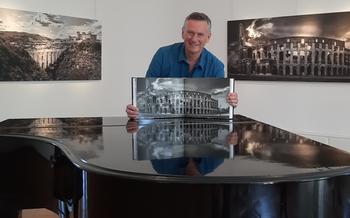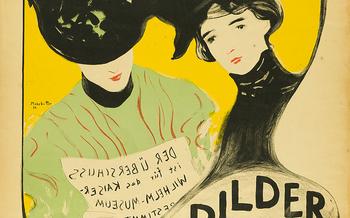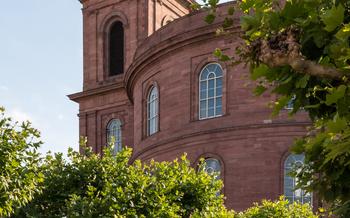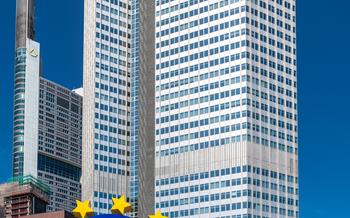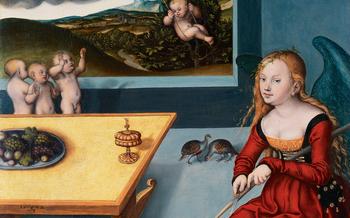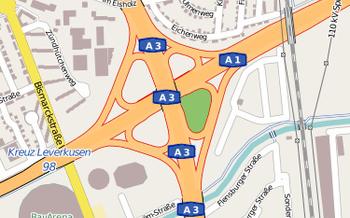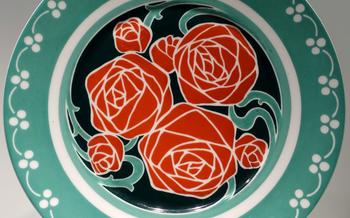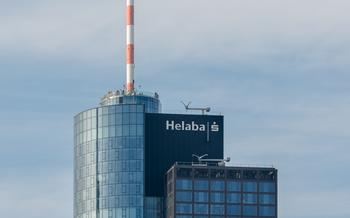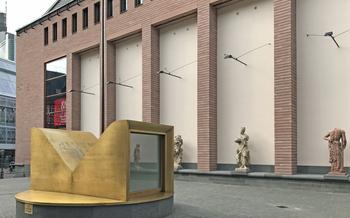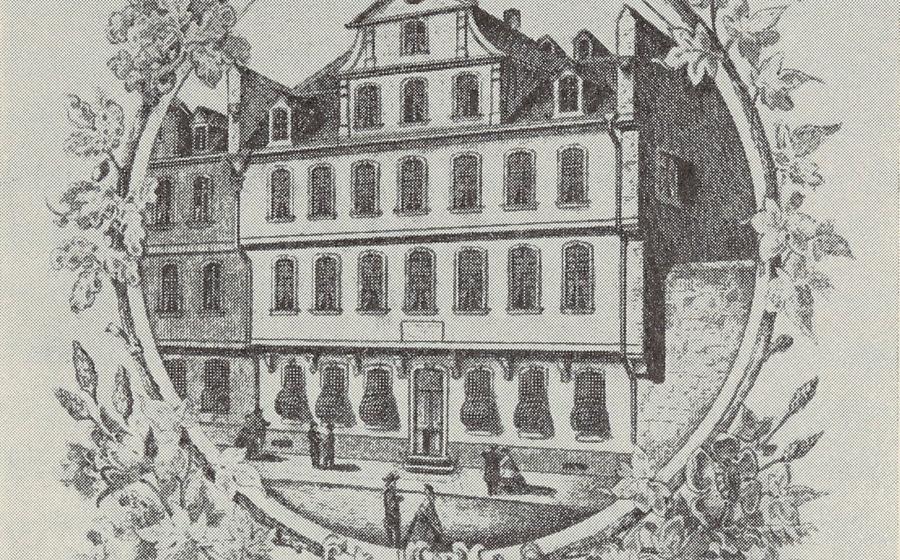
Goethe House
- Historical Significance:
- Location and Accessibility:
- Architectural Charm
- Guided Tours and Exhibitions
- Personal Belongings and Artifacts
- Interactive Displays and Activities
- Literary Insights and Manuscripts
- Cultural Events and Programs
- Educational Workshops and Seminars
- Research Facilities and Library
- Museum Shop and Souvenirs
- Accessibility for Visitors with Disabilities
- Insider Tip: Unveiling Goethe's Secret Garden
Historical Significance:
The Goethe House in Frankfurt, Germany, holds immense historical significance as the birthplace and former residence of Johann Wolfgang von Goethe, one of Germany's most revered writers and thinkers. Built in 1749, the house stands as a testament to the Sturm und Drang literary movement, which Goethe played a pivotal role in shaping. As a cultural landmark, the Goethe House offers visitors a glimpse into the life and works of this literary giant, whose writings profoundly impacted German literature, culture, and philosophy. Exploring this historic house allows visitors to delve into the mind and creative genius of one of the most influential figures in German history.
Location and Accessibility:
The Goethe House is conveniently located in the heart of Frankfurt, Germany, at Grosser Hirschgraben 23-2To reach the house, visitors can take advantage of the city's excellent public transportation system. The nearest U-Bahn station is "Dom/Römer," which is just a short walk away. Alternatively, visitors can take bus lines 30, 36, and 100 to the "Goethehaus" stop.
For those arriving by car, there are several parking garages in the vicinity, including the Domgarage and the Parkhaus Börse. However, it's important to note that parking in the city center can be limited, so it's advisable to plan accordingly.
For those who prefer to explore the city on foot, the Goethe House is easily accessible from Frankfurt's main train station, Hauptbahnhof. A leisurely walk along the picturesque streets will take you to the house in approximately 15 minutes.
To enhance your visit, consider using an interactive map or guide that provides real-time directions and highlights other points of interest along the way.
Architectural Charm
The Goethe House stands as a testament to the architectural elegance of the 18th century. Its Baroque and Rococo elements blend seamlessly to create a visually stunning masterpiece. The intricate carvings, decorative moldings, and graceful curves add a touch of grandeur to the building's facade. The house's symmetrical design and harmonious proportions reflect the architectural principles of the time, showcasing the mastery of its builders.
One of the most striking features of the Goethe House is its Rococo-style gable. The intricate scrollwork, delicate ornamentation, and cherub figures create a sense of movement and dynamism. The gable's central medallion features a portrait of Johann Wolfgang von Goethe, paying homage to the renowned writer who once called this house his home.
Stepping inside the Goethe House, visitors are greeted by a grand entrance hall, characterized by its high ceilings, marble floors, and sweeping staircase. The walls are adorned with intricate stuccowork and paintings, depicting scenes from mythology and literature. The house's interior is a testament to the refined taste and cultural sophistication of the Goethe family.
A notable architectural element of the Goethe House is its garden room. This charming space, located on the ground floor, features large windows that offer panoramic views of the lush garden beyond. The room's walls are covered in elegant floral wallpaper, creating a serene and inviting atmosphere. The garden room served as a place of inspiration and contemplation for Goethe, where he could seek solace and commune with nature.
Guided Tours and Exhibitions
Guided tours of the Goethe House are available in various languages, including English, German, French, and Spanish. Tours typically last for about an hour and provide an in-depth look into Goethe's life and works. Visitors can learn about his childhood, his literary career, and his influence on German culture. The guides are knowledgeable and passionate about Goethe, and they bring his story to life with engaging anecdotes and insights.
In addition to guided tours, the Goethe House also offers a variety of exhibitions. These exhibitions explore different aspects of Goethe's life and work, such as his relationship with Schiller, his travels in Italy, and his scientific studies. The exhibitions feature a mix of artifacts, documents, and interactive displays, which provide visitors with a deeper understanding of Goethe's world.
One of the highlights of the Goethe House is the interactive exhibition "Goethe's World." This exhibition uses touchscreens, virtual reality, and hands-on exhibits to bring Goethe's life and work to life. Visitors can explore Goethe's study, experiment with his scientific instruments, and even write with a quill pen. The interactive displays are a great way to engage with Goethe's world and learn about his contributions to literature, science, and culture.
Personal Belongings and Artifacts
Among the most fascinating aspects of the Goethe House are the personal belongings of Johann Wolfgang von Goethe that are displayed throughout the museum. These items offer a glimpse into the daily life and habits of one of Germany's most celebrated writers. Visitors can see the furniture that Goethe used, including his writing desk, armchair, and bed. They can also view his clothing, such as his frock coats, waistcoats, and hats. Additionally, the museum showcases Goethe's writing instruments, including his quills, inkwells, and seals. These artifacts provide a tangible connection to Goethe's creative process and help visitors understand the context in which his literary masterpieces were created.
One of the most intriguing artifacts on display is Goethe's writing desk. This simple yet elegant piece of furniture was where Goethe spent countless hours composing his literary works. Visitors can imagine the writer sitting at his desk, pen in hand, as he poured his thoughts and emotions onto paper. Another highlight of the collection is Goethe's armchair, which he often used for reading and contemplation. The chair is upholstered in a rich red fabric and features intricate carvings on its arms and back. It is easy to imagine Goethe sinking into this armchair, lost in thought or engrossed in a book.
The Goethe House also displays a variety of personal items that belonged to Goethe's family members. These include his mother's sewing box, his sister's dolls, and his children's toys. These artifacts offer a glimpse into the domestic life of the Goethe family and help visitors understand the writer's personal relationships.
The preservation and restoration of these artifacts is a testament to the enduring legacy of Johann Wolfgang von Goethe. Through these personal belongings, visitors can gain a deeper appreciation for the life and work of one of the most influential figures in German literature and culture.
Interactive Displays and Activities
The Goethe House offers a range of interactive displays and activities that bring Goethe's life and works to life. Touchscreens and virtual reality experiences allow visitors to explore the house and its history in a truly immersive way. Hands-on exhibits invite visitors to engage with Goethe's writings and ideas, providing a deeper understanding of his creative process and legacy. These interactive elements enhance the visitor experience, making the Goethe House not just a museum but a dynamic and engaging space for learning and discovery.
I remember being particularly fascinated by the interactive display that allowed me to virtually explore Goethe's study. I could see his desk, his books, and even the view from his window. It felt like I was stepping back in time, getting a glimpse into the world of one of Germany's greatest writers.
Literary Insights and Manuscripts
The Goethe House is a treasure trove of literary artifacts, offering visitors a glimpse into the creative mind of one of Germany's greatest writers. The collection includes a vast array of Goethe's manuscripts, letters, and literary works, providing a unique opportunity to explore his writing process and understand the development of his ideas. Among the highlights are the original manuscripts of his iconic works, such as "Faust," "The Sorrows of Young Werther," and "Wilhelm Meister's Apprenticeship." These handwritten documents reveal Goethe's meticulous attention to detail and his mastery of language.
One particularly fascinating manuscript is the Urfaust, an early version of "Faust" written in 177This incomplete work offers a glimpse into the evolution of Goethe's masterpiece, showcasing his early ideas and themes. Visitors can also admire Goethe's personal letters, which provide insights into his relationships, thoughts, and daily life. These letters reveal his friendships with other literary giants, such as Friedrich Schiller and Johann Gottfried Herder, and offer a glimpse into the vibrant intellectual circles of 18th-century Germany.
The Goethe House also houses a collection of rare books and first editions of Goethe's works. These volumes, some of which date back to the 18th century, are a testament to Goethe's enduring legacy and the continued fascination with his writings. Whether you're a scholar, a literature enthusiast, or simply curious about the life and works of Johann Wolfgang von Goethe, the Goethe House offers a wealth of literary insights and manuscripts that will captivate and inspire.
Cultural Events and Programs
The Goethe House is not just a museum; it's also a vibrant cultural hub that hosts a diverse range of events, readings, and performances throughout the year. These events offer visitors a chance to delve deeper into Goethe's life and work, as well as contemporary German literature and culture.
The schedule of events is always evolving, but you can expect to find regular readings by renowned authors, discussions on Goethe's works, and performances of classical music and theater. Special events, such as festivals and exhibitions, are also organized throughout the year, often in collaboration with other cultural institutions in Frankfurt.
Attending a cultural event at the Goethe House is a great way to enhance your visit and gain new perspectives on German literature and culture. Check the Goethe House website or social media channels for the latest event listings and schedules. Here are some personal recommendations:
-
Don't miss the annual Goethe Festival, held in August, which celebrates the writer's life and legacy with a series of events, performances, and exhibitions.
-
If you're interested in contemporary German literature, attend one of the regular readings by renowned authors, where they share their latest works and engage in discussions with the audience.
-
For a unique experience, join a guided tour of the Goethe House led by an actor portraying the writer himself, offering insights into his life and works.
Educational Workshops and Seminars
The Goethe House also offers a variety of educational workshops and seminars for students, researchers, and language enthusiasts. These workshops cover a wide range of topics related to German language, literature, and culture. Participants can choose from courses on German grammar and vocabulary to in-depth seminars on Goethe's works and the history of German literature. The workshops are led by experienced instructors who use interactive teaching methods and provide personalized feedback. These workshops are a great opportunity for learners to improve their German language skills, deepen their understanding of German culture, and engage in discussions with fellow enthusiasts. Whether you are a beginner or an advanced learner, you will find a workshop that suits your needs and interests. Check the Goethe House website for the latest schedule and to register for upcoming workshops.
Research Facilities and Library
The Goethe House also houses a comprehensive research facility and library, catering to scholars, researchers, and enthusiasts of German literature. The collection boasts a vast array of books, journals, and archival materials related to Johann Wolfgang von Goethe and the broader German literary landscape. This treasure trove of knowledge provides a rich resource for individuals seeking to delve deeper into the life and works of Germany's literary icon.
Accessing the library and research facilities is a straightforward process, with helpful staff available to guide visitors through the collection. Researchers can immerse themselves in a wealth of primary and secondary sources, including rare editions of Goethe's works, critical analyses, and scholarly journals. The library's ambiance fosters an atmosphere of intellectual exploration, making it an ideal setting for conducting research and gaining new insights into German literature.
Whether you're a seasoned scholar or a budding researcher, the Goethe House's research facilities offer a wealth of opportunities for learning and discovery. Take advantage of this invaluable resource to deepen your understanding of Goethe's literary legacy and the broader cultural context of his time.
Museum Shop and Souvenirs
The Goethe House Museum Shop is a treasure trove for literature enthusiasts and souvenir seekers. Located within the museum, the shop offers a wide range of items inspired by Goethe's life and works. Visitors can browse through an assortment of books, including various editions of Goethe's writings, biographies, and critical analyses. There's also a selection of souvenirs, such as postcards, magnets, and keychains featuring images of the Goethe House and quotes from the writer's works. For those seeking unique mementos, the shop offers exclusive items such as limited-edition prints, replicas of Goethe's writing instruments, and even Goethe-themed chocolates. Whether you're looking for a gift for a fellow literature lover or a souvenir to remember your visit, the Goethe House Museum Shop has something for everyone.
Accessibility for Visitors with Disabilities
The Goethe House is committed to ensuring that all visitors, including those with disabilities, have a welcoming and accessible experience. The museum features a variety of accessibility features to accommodate visitors with diverse needs. Wheelchair ramps and elevators provide easy access to all floors of the building, ensuring that visitors can explore the exhibits and participate in activities without barriers. Accessible restrooms are also available for the convenience of visitors.
Additionally, the Goethe House offers assistive devices such as wheelchairs and hearing loops to enhance the experience for visitors with mobility or hearing impairments. The museum staff is trained to provide assistance and guidance to visitors with disabilities, ensuring that they have a comfortable and enjoyable visit.
For visitors who require additional support, the Goethe House recommends contacting the museum in advance to discuss their specific needs. The staff will be happy to provide personalized assistance and make arrangements to accommodate visitors with disabilities, ensuring that everyone can fully appreciate the cultural and historical treasures of the Goethe House.
Insider Tip: Unveiling Goethe's Secret Garden
Amidst the bustling city of Frankfurt, nestled behind the walls of the Goethe House, lies a hidden gem waiting to be discovered—Goethe's Secret Garden. This enchanting oasis, tucked away from the public eye, was Goethe's personal sanctuary, a place where he found solace, inspiration, and communion with nature.
As you step through the unassuming gate, a world of tranquility unfolds before you. The garden is a testament to Goethe's love for botany and horticulture. Meandering paths lead you through a tapestry of vibrant flowers, aromatic herbs, and towering trees. Goethe meticulously cultivated this space, transforming it into a living laboratory where he conducted experiments and observed the wonders of the natural world.
Take a moment to sit beneath the shade of the ancient oak tree, where Goethe is said to have found solace and inspiration. Imagine him strolling through the garden, contemplating the mysteries of life, art, and nature. The rustling leaves and the gentle breeze create a symphony that echoes the poet's thoughts and emotions.
This secret garden is more than just a historical relic; it's a living testament to Goethe's spirit and his profound connection with nature. As you wander through its paths, you'll feel a sense of peace and tranquility, as if time has stood still within these walls.
So, when you visit the Goethe House, don't miss the opportunity to explore this hidden gem. Seek out Goethe's Secret Garden, and you'll discover a sanctuary of beauty, inspiration, and tranquility that will stay with you long after you leave.
